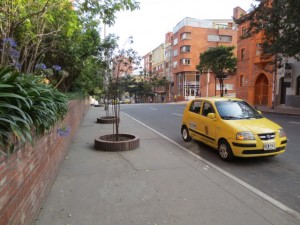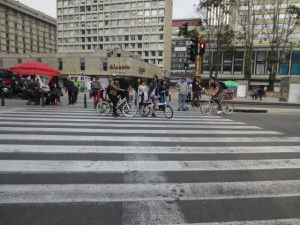My family and I arrived a few days ago in Bogotá and we have been settling in to our new lives here, and as a result I’ve not been too active on the research front. But today I got out early to experience a unique event here in Bogotá, which is its annual “Día Sin Carros,” or Day Without Cars. My street, Carrera 5, which is often very busy, has been pretty quiet all day:
As you can see, there’s a taxi here so “no car day” isn’t meant to be literal. In fact, a few blocks away on the main thoroughfare of 7th Avenue, the traffic was unusually bad during morning rush hour. But it’s pretty much all buses, taxis, delivery vehicles, motorcycles, and official government vehicles. Private automobiles are outlawed on city streets on this day, and though I’m sure they’re out there collaboration seems very high.
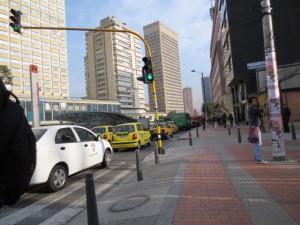 So what’s a Bogotano to do? Many ride the Transmilenio Bus Rapid Transit system to get to work and run errands, intensifying use of a system that is already heavily used. As one woman I know who normally rides Transmilenio to her job as a housekeeper complained, “This day is the worst, you really get packed in on the buses.”
So what’s a Bogotano to do? Many ride the Transmilenio Bus Rapid Transit system to get to work and run errands, intensifying use of a system that is already heavily used. As one woman I know who normally rides Transmilenio to her job as a housekeeper complained, “This day is the worst, you really get packed in on the buses.”
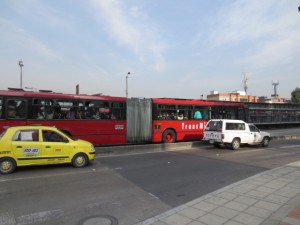 But what’s remarkable is how many people use body power to get around, mostly on two wheels:
But what’s remarkable is how many people use body power to get around, mostly on two wheels:
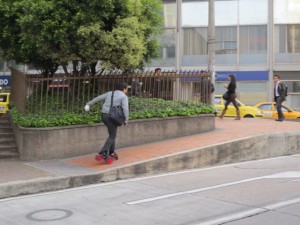 Actually, this guy is an exception. Most people are on bicycles.
Actually, this guy is an exception. Most people are on bicycles.
Promoting active transportation and especially use of the city’s major bikeway system is what this event is all about. It was begun in 2000, and while some people such as the woman quoted above complain about it, it has tremendous popular support. In fact, an effort to have Car Free Day once a month as opposed to once a year passed by popular vote but was defeated in the courts by resentful business owners who thought it would negatively affect retail shopping.
People come out in droves on bicycle, and it is not unusual to see people who do not otherwise look like hard-bitten everyday cyclists coming out on bikes they normally use for recreational Sunday Ciclovía events (car free streets). You can tell by their somewhat widened eyes and unstable movements in traffic.
I even observed several bicycle caravans helping college students get to their universities. In recent weeks, bicycle advocates have been organizing such caravans in preparation for today to teach people routes, what to wear, and to develop confidence in bike riding–which can be quite harrowing in Bogotá traffic even with the massive bikeway system of separated lanes. But no matter who they are, people are wearing their street/work clothes and riding bicycles that are meant for comfort and practicality and not speed.
Streets stay open to motorized vehicles, but on major streets one lane is cordoned off with cones for non-motorized use. There is some mixing of modes as you can see in this short video.
In some cases, whole roads–no, sides of a freeway–are set aside, as in this time lapse video:
In a city of this scale, No Car Day is a major logistical undertaking involving thousands of police and city officials whose presence can be felt in almost any major intersection.
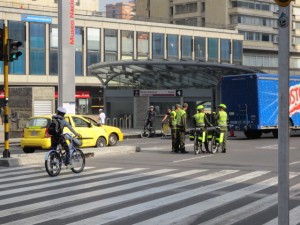 I find it hard to imagine a North American city pulling this off. Not only would the resistance from suburban commuters be strong, but no city is currently prepared to handle the logistics. Bogotá can do it because it already closes down some 133km of city streets every Sunday and holiday for Ciclovía so it has the institutional experience and systems in place already.
I find it hard to imagine a North American city pulling this off. Not only would the resistance from suburban commuters be strong, but no city is currently prepared to handle the logistics. Bogotá can do it because it already closes down some 133km of city streets every Sunday and holiday for Ciclovía so it has the institutional experience and systems in place already.
P.M. Update: It’s remarkable out there post-morning rush-hour. The streets are surprisingly mellow, many people still on bikes, and the number of buses and taxis is much lower. As a pedestrian one gets a sense of–almost, but not quite–tranquility that is unusual in such a large city.
